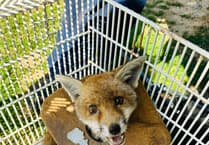WHILE vaccination of badgers will, no doubt, help to eradicate badgers as carriers of bovine tuberculosis (bTB), I doubt if it will make much difference to the incidence of bTB in cattle.
Testing cattle for bTB began in the 1930s by the Ministry for Agriculture, Fisheries, and Food (MAFF) and Montgomeryshire (now part of Powys) became the first county to be declared free of the disease in the same decade.
In the next 30 years, the disease was practically eradicated from the British Isles. Cattle were tested annually and those that reacted were culled, as is done today, the difference being that all cattle were tested then.
During this period, movement of cattle was very strictly controlled. Only TB-free cattle were allowed to be moved and counties that became free of bTB were not allowed to import cattle from counties that were not free of the disease. A system of double-fencing was introduced so that cattle from different herds could not touch one another, a fertile source of cross-infection.
Some cattle breeds were more susceptible to infection than others and these breeds were culled, so that most British cattle were, by the 1960s, breeds that had a resistance to bTB.
Since then, many herds have been replaced with continental breeds, which do not seem to have the same resistance. In addition, herds are much larger than they used to be and they are housed in larger buildings where ventilation is likely to be poorer and this tends to reinforce the disease.
If these methods worked in earlier decades, it’s difficult to see why they wouldn’t work now if they were re-introduced. bTB-free herds have become a reality in Scotland and it achieved its Officially Tuberculosis Free status in 2009. There are few differences between Scotland and the rest of Great Britain in agricultural terms, although it is colder on average.
Scotland has badgers, just as we do, yet there have been no widespread culls. In contrast, the Isle of Man has no badgers, yet it is not free of the disease, although the incidence is low.
Totals of cattle culled for all reasons provide interesting reading. In the average year there are about 120,000 cattle culled because they are infertile, about 90,000 for mastitis, and about 30,000 for lameness. Farmers receive no compensation for these animals. There are about 30,000 cattle culled annually because of bTB, which is less than a tenth of the total.
A feature that is rarely considered in the volumes that have been written about bTB is the unnatural life to which modern cattle are subjected today. They have become milk-making machines and most Devonians will be familiar with the sight of cows with udders so large that it is impossible for them to walk properly.
Most farm animals live unnatural lives to increase yields. What effect does that have on health? In human terms, obesity is not the same as over-large udders in cows, but it represents a human condition that isn’t natural, and obese people are certainly more susceptible to illness, particularly diabetes, than people of a more natural size. There is likely to be a similar effect in cattle.
Much of this information comes from George Pearce’s book, Badger Behaviour, Conser vation and Rehabilitation. He was a farmer and had a herd that was bTB free from 1950 until 2008, when the herd was dispersed, so he’s not a pontificator on the side-lines.
He makes one final point about the influence of badgers on bTB in cattle: ‘… the badger’s lifestyle has not altered for many thousands of years. Disease or no disease, they have survived. In the cattle industry, the increase of bTB has happened in parallel with the changes in management of dairy and beef cattle, and if I were farming today, that’s where I would want the research concentrated.’ Me too.
K Vines
Horrabridge



